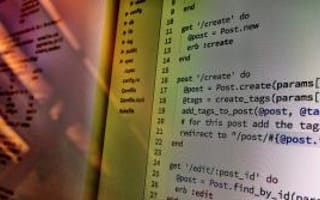Whether you want to found a startup that will become the next Facebook or simply carve out a sustainable career, giving yourself a firm foundation in the practice and theory of web development is a great place to start.
Fortunately, there is no end of freely available resources on the web for learning the technologies that were used to build it. Not all free resource are equal though, so instead of letting you set out on your voyage to web development niggadom on a sea of inscrutable tutorials, we’re going to point you in the direction of some high-quality educational resources.
The Basics
Before you start building your web app or site you’re going to need to have a firm grip on the basic languages and technologies.
Code Academy Web Fundamentals
If you already know how to build a website with HTML and CSS, you can probably give this one a miss, but otherwise Code Academy’s Web Fundamentals course is the perfect place to pick up the foundations.
Once you’ve worked your way through this course, Code Academy offers a solid set of courses that delve into the basics of JavaScript, PHP, jQuery, Python, and Ruby.
Webdesigntuts+
Webdesigntuts+ is a comprehensive online resources that is focused on web design rather than web development per se, but it certainly won’t hurt newbie developers to learn a bit about design.
The link above points to Webdesigntuts+ roundup of basic tutorials that cover everything from HTML and CSS basics, and web design software like Photoshop and wireframing tools to responsive web design.
Udacity Web Development Course
In this course, which is lead by Reddit co-founder Steve Huffman, you’ll get down to the nitty gritty of web development, including how the web works from a technical perspective, managing databases, user authentication, connecting to APIs, and scaling.
JQuery Fundamentals
As you probably already know, JavaScript is the language used to add interactive elements to a website. JQuery is a popular library built on top of JavaScript that makes it much easier to to do things like add interactivity to your site, create animations, and communicate with a server without reloading the page. JQuery Fundamentals starts with the basics of JavaScript, before diving deep into JQuery.
Sass or Less
Sass and Less are both CSS preprocessors. They can be considered as extensions of CSS – the language used to control how websites look – that add features lacking in the original CSS specifications, such as variables, partials, and mixins, but which can be compiled into correct CSS that will work in most modern browsers. They make CSS much more pleasant to work with. Which is best is another of those ongoing debates that I don’t want to wade into, so you should check them out yourself and see which suits you.
-
Sass Basics will explain everything you need to know about Sass.
-
An Introduction to Less, and Comparison With Sass will give you a basic grounding in LESS and explain the differences between the two.
Pick A Server-Side Language (Or Learn Them All)
There’s a ton of options for server-side scripting with novel languages popping up frequently, but there are three clear leaders: PHP, Python, and Ruby. Each has its relative strengths and weaknesses. I’m not going to get into a conversation about the merits of each here. But, I will point you in the direction of three resources that will help you build a firm foundation in the web’s most popular languages.
-
For PHP I’m going to suggest Code Academy again. Its PHP course is probably the best beginner-level introduction around.
-
Learn Python The Hard Way doesn’t sound very enticing, but it’s a solid introductory book, which is freely available online. If you really want to get a firm grasp of programming in general and Python in particular, How To Think Like A Computer Scientist: Learning With Python is a great option, although it’s not focused on web development.
-
Why’s (poignant) Guide to Ruby is a programming book with a difference: it’s actually fun to read. _why is a legend in the Ruby community, and his book is a excellent place to get started. If you’ve decided to learn Ruby, you’ll most probably also want to take a look at Ruby on Rails.
These courses, tutorials, and books should give you a fairly firm grasp of the necessary knowledge to make inroads into web development. When you launch your first app, don’t forget about the web hosting company that put you on the right track: a Virtual Private Server makes a perfect development and production environment for new apps and sites.
About Rachel Gillevet - Rachel is the technical writer for WiredTree, a leader in fully managed dedicated and vps hosting. Follow Rachel and WiredTree on Twitter, @wiredtree, Like them on Facebook and check out more of their articles on their web hosting blog, https://www.wiredtree.com/blog.



